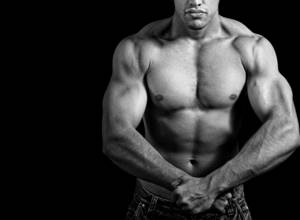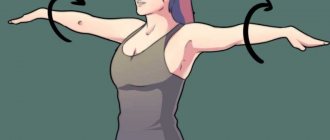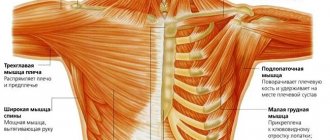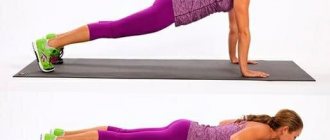Hello friends. We continue to provide you with useful and necessary information. Today we will look at the best exercises for training the pecs and triceps. This article is just a text version of the video. The video itself is located at the bottom of the page. Those who cannot or do not want to skip a significant amount of text can simply turn on the video. And those comrades who want to read - well, welcome.
This series of articles examines the use of muscle bundles in various exercises. And the links are not to subjective data. The basis is specific research. This study was conducted 7-8 years ago by Bret Contreras, a very famous American trainer. He became interested in which exercises used which muscles worked more. In particular, breasts. We have dumbbell presses, barbell presses, different angles, we have dumbbell flyes, machine flyes. There are a huge number of exercises, and you need to determine which of these exercises work better and which ones work worse.
And so Contreras conducted a corresponding study using electrical myostimulation. What is electromyostimulation? This is when sensitive sensors are attached to all the bundles, which measure electrical activity during contraction. That is, the more the muscle contracts, the greater the activity. That is, using this indicator you can find out in which exercises a particular muscle works more, and in which exercises it works less. For a better understanding, it is worth reading the previous article in this series, which discussed exercises for the shoulders and upper trapezius. Today we’ll talk about the most effective exercises for training the pectorals and triceps.
Why pecs and triceps? Because traditionally, when training chests, the entire pushing group is used. That is, a bench press group. We have pulling exercises where we bring ourselves closer. There are pushing exercises, when we push the projectile away from ourselves. So, when we train the chest, and it is a classic pressing muscle group, in many exercises, at least in the pressing ones, in addition to the chest, the triceps always work. That is, the triceps is a muscle that almost always works in conjunction with the chest, if we are talking about some basic exercises such as barbell and dumbbell presses with different grips. Therefore, it will be interesting to figure out which exercises are best for the pecs and which for the triceps. And among them there was some specific rank so that we could highlight which exercises work best on the top of the chest, the middle of the chest and the bottom of the chest.
Go.
| EXERCISE | Upper chest | Mid chest | Bottom of chest | Long head of triceps |
| Light bench press | 125.0 230.0 | 181.0 408.0 | 116.0 347.0 | 47.8 109.0 |
| Heavy bench press | 109.0 198.0 | 177.0 288.0 | 130.0 345.0 | 73.5 153.0 |
| Positive Incline Bench Press | 130.0 261.0 | 156.0 422.0 | 89.4 337.0 | 55.8 109.0 |
| Dumbbell bench press | 122.0 192.0 | 204.0 451.0 | 88.1 252.0 | 43.7 128.0 |
| Positive Incline Dumbbell Bench Press | 128.0 310.0 | 124.0 286.0 | 59.0 172.0 | 35.5 98.9 |
| Dips (no weight) | 73.7 164.0 | 105.0 234.0 | 124.0 266.0 | 73.9 150.0 |
| Dips (with weight) | 140.0 232.0 | 192.0 332.0 | 214.0 418.0 | 124.0 217.0 |
| Close grip barbell press | 106.0 211.0 | 137.0 229.0 | 77.5 217.0 | 52.6 107.0 |
| Guillotine barbell press | 114.0 302.0 | 176.0 511.0 | 169.0 502.0 | 61.9 142.0 |
| Bench press | 132.0 265.0 | 197.0 356.0 | 154.0 347.0 | 64.8 170.0 |
| Dumbbell flyes lying on a horizontal bench | 133.0 231.0 | 195.0 493.0 | 160.0 450.0 | 14.9 31.3 |
| Dumbbell flyes lying down with a positive incline | 125.0 249.0 | 135.0 344.0 | 77.3 257.0 | 12.6 20.0 |
| Bringing your arms in front of you in a crossover with high rollers | 107.0 201.0 | 168.0 311.0 | 153.0 397.0 | 9.6 19.1 |
| Bringing your arms in front of you in a crossover with medium rollers | 154.0 252.0 | 154.0 271.0 | 124.0 251.0 | 11.5 23.1 |
| Bringing your arms in front of you in a crossover from the lower rollers | 135.0 233.0 | 78.6 249.0 | 36.9 74.8 | 20.2 77.2 |
| Push-ups without weight | 109.0 204.0 | 124.0 252.0 | 101.0 194.0 | 24.0 38.7 |
| Close grip push-ups | 103.0 188.0 | 118.0 188.0 | 70.7 119.0 | 22.9 43.2 |
| Bench push-ups | 96.6 156.0 | 102.0 232.0 | 52.7 167.0 | 24.0 46.6 |
| TRX hanging push-ups | 113.0 206.0 | 166.0 363.0 | 177.0 352.0 | 35.3 107.0 |
| Pullover lying on a bench | 55.7 119.0 | 88.6 186.0 | 53.8 164.0 | 66.9 153.0 |
| Handlebar Press in Block Frame | 143.0 272.0 | 45.7 91.0 | 53.0 127.0 | 21.0 52.6 |
| French bench press | 45.6 89.5 | 21.5 48.6 | 70.7 118.0 | 116.0 172.0 |
| Extension on a pulley with a rope handle | 6.9 14.9 | 5.4 21.9 | 36.1 82.5 | 135.0 276.0 |
| Extension on a block (straight handle) | 9.3 21.3 | 9.3 18.7 | 78.2 172.0 | 132.0 255.0 |
| Extensions from behind the head on a block | 19.4 41.0 | 19.2 130.0 | 40.6 126.0 | 109.0 206.0 |
Upper chest exercises
Number one, the best exercise available for training your upper pecs is the positive incline dumbbell bench press. There is simply no better exercise than this one in terms of engaging your pecs. No dumbbell flyes, no incline bench presses - it will all be much worse. Remember, if we talk about an ideal situation, experience has shown that the first place for the upper chest is the dumbbell bench press with a positive incline.
Second place goes to a specific exercise called the Guillotine. You can google, look, study. This is truly the best exercise. Why? Firstly, because it is very effective for the upper pectoral muscles. The difference between the Guillotine and the overhead dumbbell press is very slight. These exercises practically go side by side. Even though the guillotine is performed on a horizontal bench. But due to this specific technique, when you lower the bar of the barbell not on your nipples, but on your throat (that’s why the name is), and due to this technique, all three parts of your pecs are involved. That is, the middle part, the lower and even the upper part work very actively. And if in the middle and lower parts this exercise is almost the most effective of all possible, then speaking about the upper part for our pecs, this exercise is slightly inferior to the dumbbell bench press.
The third place is also occupied by the barbell press. But somewhat specific: bench press lying on the floor. This exercise is very rarely done. The only people who do this exercise more or less regularly are, as a rule, wrestlers and representatives of mixed martial arts. Because this type of press allows you to work with large weights in a partial amplitude. And it has great functionality. Let's say when you are fighting, you can push someone aside, lean back. This is a very functional movement. And it trains very well when you lie on the floor and press not on the bench, but on the floor. This exercise is much more effective than a regular horizontal barbell bench press. Despite the fact that the amplitude is shorter. Why? Because when you bench press, you tend to bridge to some degree. Because your feet are on the floor and your spine is on the bench. Accordingly, there is some certain deflection. To avoid this deflection, you need to raise your legs on the bench - then you won’t be able to cheat, then your chest will work more isolated.
Let's say, a bodybuilding scheme for performing all barbell presses is without cheating and without bridges. To make it harder for your pectoral muscles to work. All other sports try to make it easier for their muscles to work because they need functionality, not size. The technique is simple. You lay down on the floor, adjust the racks - and take it and start working. True, you need to reconfigure a little, because it’s unusual. You have to work in partial amplitude. At the bottom point, your elbows rest on the floor, and you cannot lower them all the way. But on the other hand, it gives a certain comfort, a certain feeling of security. You can do this on your own, without a partner. And don’t be afraid that you will be crushed. When you lie on the floor, you have a gap between the bar and the floor, you won't be crushed in any way. In this regard, it is more calm and safe. And the trick: in this exercise, despite the fact that we are talking about the bench press on the floor, the horizontal press, we are now discussing the rating of the best exercises for the upper chest segment, strange as it may seem. So, the horizontal bench press on the floor engages this part of the pecs very well, unlike a regular bench press.
The fourth place is a crossover with medium rollers. Block frame, middle rollers. There are three roller positions in the block frame. You can work on the chest with high rollers, with medium rollers, or with low rollers. It is believed that when you work from the lower rollers, your upper chest works more, when you work from the upper rollers, your lower chest works more, and when you work on the middle rollers, it seems like the middle part of your chest works. In fact, this is not entirely true. Let's say for the lower chest - to some extent, yes, but this is not the most effective exercise. As for the top of the chest from the lower rollers, this does not work at all. Remember: the most effective position that works the most on your chest, midsection, and upper body is when the rollers are level with your chin or your nose. Middle position. With this position, among other things, the exercise ranks fourth in the ranking of the best exercises for the upper part of your chest.
And fifth place is shared by exercises such as dumbbell flyes lying on an incline bench with a positive incline and the barbell bench press lying on an incline bench with a positive incline. These traditional exercises, which are considered almost the best, are in fact not the best. And if you choose something most effective for the upper chest, then in this regard the dumbbell bench press with a positive incline takes first place. That is, here is our ranking for the upper pecs. And we move on to the middle part.
Three day split
A three-day split is one of the most common training schemes, which allows you to group muscle groups in such a way that the athlete has time to train each muscle in one circle, and at the same time, so that they have time to reach the moment of supercompensation. It goes without saying that for this it is necessary to group muscle groups correctly within each workout. In order to achieve this, it is necessary to follow two important rules: train one large and one small muscle group in one workout, and also combine muscle groups in such a way that these muscles are antagonists. The most common option is to combine chest and biceps, back and triceps, and legs with shoulders.
The advantages of such an organization of a three-day split are obvious! First, the two principles listed above are respected. During the first workout, the athlete pumps the chest and biceps; the chest is a large pushing muscle group, and the biceps is a small and pulling muscle group. The back is also a large muscle group, but, unlike the chest, it pulls, and the triceps is small and pushes. The legs are generally the largest muscle group in the human body, and the shoulders only engage the leg muscles in the military press or other standing presses. At the same time, the shoulders are the largest small muscle group, and training the legs stimulates the release of hormones, so training the shoulders with the legs is most effective. It is also important to note that the large muscle group should always be trained at the beginning of the workout, and the small muscle group at the end.
Benefits of a 3-Day Split
Sufficient amount of rest - this advantage lies in the fact that enough time passes between training large muscle groups, at least one week, which is enough for both beginners and more experienced athletes. More experienced athletes can use microperiodization, dividing workouts into light, medium and heavy. Thus, the athlete will be able to develop different muscle qualities of large muscle groups, as well as achieve the moment of supercompensation before each workout. But this does not mean that the chest should be trained in the same way as the legs. Most likely, leg workouts will have to be divided into light, medium and heavy, and chest workouts into light and heavy. But in order to accurately determine the required time to achieve supercompensation of different muscle groups, the athlete must keep a training diary. Beginner athletes can simply train, following the principle of load progression.
The scheme is suitable for athletes of different levels - the mechanism of this advantage of a three-day split has already been described above. Here I would like to say in more detail about what these differences are associated with. The fact is that as muscle mass increases, muscles begin to recover more slowly, which is logical; the larger the muscle, the more time it needs to recover. The need for muscle recovery lies in the fact that bodybuilding involves constantly increasing the load from training to training, since this is the only way to force the body to hypertrophy muscle fibers. If the load does not increase, then the body will have no need to increase muscle volume. And in order for an athlete to be able to increase weight on the barbell, he needs to train at the moment of supercompensation. Remember , if you manage to progress the load, this will mean that the scheme is working. There are no working schemes, just each training program has its place and time, and you should change the training program only when it no longer allows you to progress further!
Small muscle groups are trained twice a week - this is due to the aforementioned grouping of muscle groups during the split. The fact is that when an athlete trains the chest, the triceps also receive a load, and when training the back, the athlete also trains the biceps. Moreover, since during training of large muscle groups the biceps and triceps receive an indirect load, this creates a microperiodization effect. Large muscle groups are trained once a week, which is suitable for inexperienced athletes who do not yet know how to train different muscle qualities, alternating light and heavy training. But because of this, the training scheme is less flexible, resulting in a number of disadvantages.
Exercises for the middle part of the pectorals
The most effective exercise for training your midsection is the guillotine style bench press. In general, this is a unique exercise. This is the best exercise for all three sections of your pectoral muscle. This is generally the best exercise for training your chest in terms of engaging the intensity of your muscle fibers. There is nothing better. The main thing is not to chase the scales, learn the technique. Because at the bottom point there is a very strong stretch. When you lower the barbell onto your throat, there is a very strong tension. Sometimes you can avoid touching your throat with the bar. The middle and top portions tend to lag more often. The lower part of the pecs is usually fine in everyone. But there are questions with the middle and top.
Second place goes to dumbbell flyes lying on a horizontal bench. A fairly well-known and simple exercise in which the elbow joint does not move, and movement occurs only due to movement in the shoulder joint. Due to this, isolated work with the chest occurs. And given that there is no tilt, the middle part of the pecs works more.
The third place is also occupied by a horizontal bench. Dumbbell bench press on a horizontal bench.
The fourth most effective exercise is the bench press with a positive incline. Traditionally, people think that this exercise is for training the upper pecs, but this is not entirely true. There is information about this, if anyone is interested, you can google it. A slight incline is not an attempt to shift the load to the upper pecs. The slight upward tilt is an attempt to give your pecs a more even load so that your midsection works more evenly. And we move on to the lower part of the pectoral muscles.
Anatomical connection
As a rule, moving the arm back causes tension in the pectoral muscles – small and large. At the same time, barbell presses, deadlifts, or bent-over dumbbell raises that target the triceps have just as much impact on the chest. You could say that the chest and triceps complement each other, with the arms taking most of the load.
Without strong triceps, you will not be able to work with normal weight, which is why you will need to use lighter weights when pumping up your chest. Therefore, all athletes adhere to this scheme: first they pump their arms, and only then they need to move on to general exercises on the arms and chest.
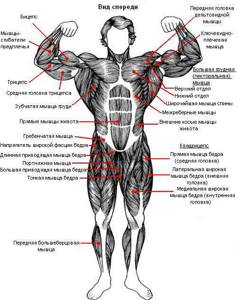
Exercises for the lower pectoral muscles
There will be a few surprises here. The fact is that the first two exercises are identical to the most effective exercises for the middle part of the pectorals. That is why, as a rule, the lower part is almost always overdeveloped, while the middle and upper parts are almost always lagging behind. Because in so many exercises the load is taken by the lower sections.
The first most effective exercise for training the lower part of your pecs is the guillotine style bench press. The same exercise that Vince Gironda invented, and which, in general, is quite well known abroad. But for some reason no one ever does it here. Try it in your chest workouts - you will find a lot of pleasant surprises. And the pumping sensations are different. and there will be pain.
Second place goes to dumbbell flyes lying on a horizontal bench. The same exercises as for the middle of the pecs.
The third place is occupied by such an exercise as push-ups on uneven bars with weights. Please note: it is very important that this be done with weight. Not only because the load changes. The fact is that when you do push-ups with a weight, the vector itself also changes. You hold a slightly more upright position. And when you do push-ups without weight, you lean forward very much. In order to shift the load to the lower parts of the pectorals, you need to maintain a more vertical position. And weight helps in this regard. That is, you have placed some weight on your belt, and your position has become more favorable for engaging the lower part of your pectoral muscles.
A lot depends on the goal here. Maybe you're not using this exercise to emphasize your lower pecs. Although it is recommended, because in this position both the triceps work well and the pecs work well.
The fourth exercise closes our chart. Block frame, top rollers. Bringing your hands together in a crossover from the top rollers. When we pull from top to bottom, this load is mainly carried out by the lower parts of our chest. There are a lot of exercises. The table contains these exercises and numbers - you can see which is more effective and which is less effective. Now we are talking about the most effective ones. The fact that dumbbell flyes are in second place for the lower pecs does not mean that this exercise is so-so, you only need to do the guillotine. All four of these exercises that are listed are the cream of the crop, the elite. Any of them can be taken to train your pectoral muscles.
And we still have triceps. Go.
Ways to train your chest
Working out the pectoral muscles is quite labor-intensive.
In general, the training scheme looks like this:
dips;
lying dumbbell lift;
Let's look at all the exercises in detail.
Dumbbell Bench Press
This exercise with dumbbells perfectly works the chest, arms and shoulders (front deltoids).
Starting position: lying on a sports bench with your head up, shoulders on a horizontal surface, elbows bent and slightly apart, dumbbells lying in your hand above your chest at the level of your collarbones.
Tightening your muscles, you should forcefully push the shells upward, fully straightening your arms.
Hold at the top point for a second and slowly lower the dumbbells to the starting position.
You need to perform at least 2-3 sets of 20-25 repetitions.
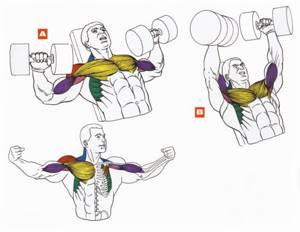
Lying dumbbell flyes
Such exercises not only add volume to the pectoral muscles, but also serve as an analogue of gymnastics and stretching for the torso.
You need to do the following:
Starting position: lying on your back, arms apart, holding a dumbbell in each palm with a neutral grip.
Raising your hands up, you need to connect the shells. Your arms should be slightly bent at the elbows throughout the entire exercise.
As you exhale, lower the dumbbells as low as possible until you feel a clear feeling of a good stretch in the ligaments and elbows.
It is necessary to perform 2-3 sets of 20-25 arm raises.
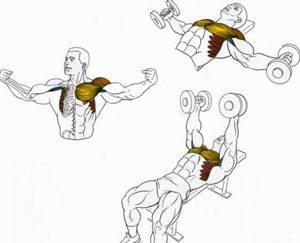
Dips
This exercise requires a certain level of physical fitness: you must be able to stand on your hands on parallel bars for a long time.
Stages of the exercise:
Standing on the apparatus, arms fully straightened, legs bent at the knees and crossed so as not to sway.
As you inhale, you need to bend your elbows and lower yourself down, trying not to tilt your body or arch your back.
As you exhale, you need to return to the starting position.
Do 50-60 repetitions of push-ups in total for 2-3 approaches.

This exercise is extremely effective not only for the muscles, but also for the condition of the spine.
Take the dumbbell with both palms and place it behind your head while lying across the bench.
Having raised the projectile with straight arms above the chest, you need to slowly lower it as low as possible until a feeling of pleasant stretching appears.
Return to starting position.
Do 20-30 repetitions - two sets. It is very important to monitor your breathing: you need to lift the load as you exhale, and as you inhale, lower it down to the floor. You can put your head up and lie down completely on the bench - then the complexity of the exercise will increase.
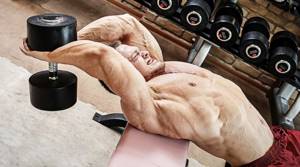
Triceps exercises
In general, Contreras did not test the entire triceps. Everyone knows that the triceps consists of three heads. But Contreras tested the long head, tested how it worked in a variety of exercises to understand which ones were best to use for training the long head. And there are surprises here too. There is such a traditional point of view in bodybuilding. In order to work the long head of the triceps, the exercises must be done in a stretched position from behind the head. All these extensions and French presses are considered to involve the long head of the triceps more. And from the point of view of pumping, in theory, it would be necessary to use just such exercises. But the experiment showed that this is not so. The experiment showed amazing things.
The first place, the most effective of all possible options for training the long head of your triceps, is the cable pulley extension. The peculiarity of this exercise is that it is not just straightening down at the elbow joint, but you also need to turn your arms a little at the lowest point. The palm pronates, and due to this pronation, you additionally activate the triceps. This is the best, most effective exercise for training the long head of the triceps.
The second exercise is almost the same. But we are already using a straight handle. That is, arm extensions on the upper block with a straight handle. This exercise takes an honorable second place.
The third place is occupied by such an exercise as push-ups on uneven bars with weights. It is good for both the pecs and for training the long head of the triceps.
And only fourth place is occupied by extension from behind the head on the upper block. Or with dumbbells. If we talk about such a traditional exercise as the French bench press, then it occupies only fifth place in the ranking. That is, this is not the most effective exercise. And many intuitively feel this. Extension on a block works better and is more effective for the long head of the triceps.
These are the revelations.
How to pump up your chest and triceps: comprehensive training
Each cell of our body is interconnected with another - this is a well-known fact. The body is connected not only by blood or by the power of nerve fibers - some organs function better at the same time than separately. Some muscles in the body work in pairs. For example, biceps and triceps, chest muscles and triceps. If you want to quickly pump up your upper body, this article is especially for you. In it you will learn how to pump up your chest and triceps in a comprehensive workout.
